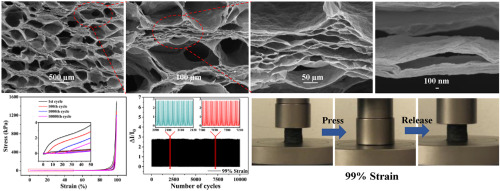Abstract
Herein, a facile hydrothermal self-assembling strategy is employed to prepare a reduced graphene oxide (rGO) aerogel with a multi-scale hierarchical cellular structure inspired by deep-sea glass sponge. This hierarchical cellular structure of the rGO aerogel, obtained by changing the carbon wall to cellular structure, can be broken down into six levels from the nano-to the macro-scale. Remarkably, the rGO aerogel, with multi-step reductions, shows significant flexibility and toughness under extra-high compressions: 99.9% of the original height is remained after 20 000 compression cycles at a high strain of 90%, whereas 79.8% of height is still preserved after 10 000 compression cycles at an extreme strain of 99%. Moreover, the rGO aerogel demonstrates outstanding compressive strength: the stress of 1.5 MPa under 99% strain and the ratio of strength to density of 177 kPa cm(3) m g(-1), which overcomes the shortcoming of low stress tolerance for general graphene aerogels. In addition, the rGO aerogel shows high electrical conductivity of 42.7 S m(-1) and exceptionally stable current signal response even after tens of thousands of compression cycles under extreme strain (99%). The outstanding properties of this graphene aerogel demonstrate its promising potential as a piezoresistive sensor with high stability and wide detection range. (C) 2022 Elsevier Ltd. All rights reserved.

Keywords Plus:OXIDEREDUCTIONNANOCELLULOSENANOSHEETSHYDRAZINECELLULOSEGRAPHITESPICULES
Published in CARBON,Volume191;10.1016/j.carbon.2022.01.055,MAY 2022


